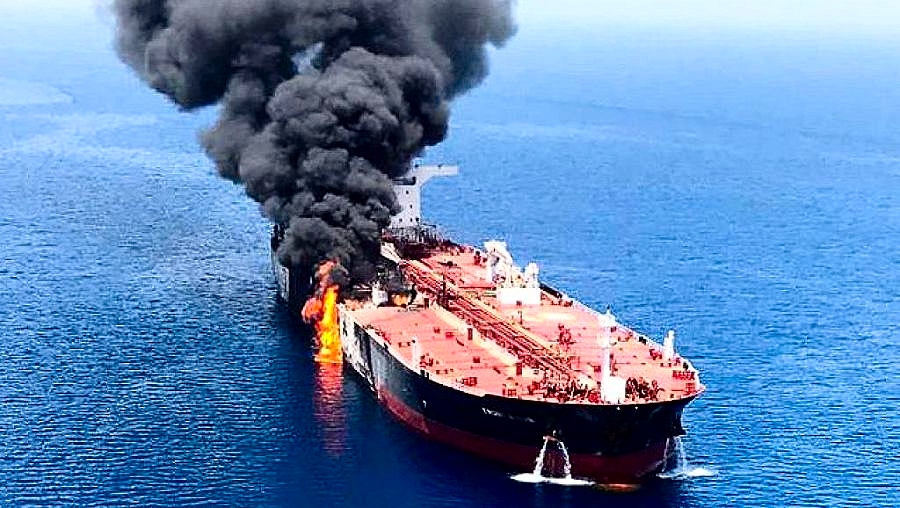TOWARDS A WAR BETWEEN IRAN
AND THE UNITED STATES OR THE TORPILLAGEOF TWO PETROLERS IN THE GULF |
|
| Oil tankers were allegedly attacked this Thursday near the Strait of Hormuz, a passage of a third of oil exports in the world.
An area where tensions between Iran and the United States have crystallized for two years. The vessels in question are the Altai Front and the Kokuka Courageous, respectively under the flag of the Marshall Islands and Panama. The Front Altair and Kokuka Courageous vessels were reportedly "attacked" in this strategic area amid a crisis between the United States, the Gulf States and Iran. The sailors would have been collected by Iran while the Fifth Fleet American would be on the spot. The hypothesis of "torpedoing" is mentioned.
Even if the situation is still confused, these incidents take place in a maritime zone strategic for the world trade but also hot spot of geopolitical tensions against a background of persistent crisis between the United States and Saudi Arabia on the one hand and the Iran and its Shiite allies on the other. Regarding the origin of these serious incidents, the hypothesis of a torpedoing of these ships is mentioned by Tradewinds newspaper, citing industrial sources. This assumption would apply for the Altair Front which carried 75,000 tons of naphtha. "He may have been hit by a torpedo" around 4:00 am GMT, said Taiwan's CPC oil company CEO Wu I-Fang, the recipient of the cargo. The second vessel, Kokuka Courageous, a 27,000-ton tanker, was fired but the entire crew was rescued after the vessel was abandoned, and its cargo of methanol is intact, said its Japanese operator Kokuka Sangyo. "It appears that other ships have also been fired," company president Yutaka Katada told reporters in Tokyo, confirming information from his Singapore parent company about a "security incident." Mediation in Iran between the Japanese Prime Minister and Ayatollah Khamenei In May, a series of similar sabotage was attributed by the United States and Saudi Arabia to Iran, in a context of extreme tension between Washington and Tehran on nuclear power. Iran has expressed "concerns" after "suspicious incidents". At first, Tehran spoke of an "accident" and reported that it had rescued "two foreign tankers" in the Arabian Sea. This new attack took place even as the Japanese Prime Minister met Ayatollah Khamenei in Iran to try to defuse the crisis. Japanese Prime Minister Shinzo Abe has been in Tehran since Wednesday, June 12, for a two-day visit to open a rare public channel for discussion between the United States and Iran. These diplomatic efforts took place as Tehran signaled its willingness to stop meeting its nuclear commitments one year after the US withdrew from the agreement in May 2018, and while US sanctions against Iran are considered as acts of war. Tehran has given until July 7 to the other signatories of the agreement (China, Russia, France, United Kingdom and Germany) to moderate the weight of these sanctions that threaten to reduce its GDP by 6% in the year, according to the International Monetary Fund. To the Iranian Foreign Minister to judge then extremely suspicious the coincidence between these "attacks" and the visit to Tehran of the Japanese Prime Minister Shinzo Abe. "The suspicious word is not enough to describe what transpires apparently" of these "attacks" against "Japanese-bound tankers that occurred while the prime minister (Japanese) met" the Iranian Supreme Leader in Tehran, writes Mohammad Javad Zarif on Twitter . Why such a renewal of tension? Considered an international transit area, this narrow passage at the mouth of the Persian Gulf is used by Iran as a lever against US sanctions, which aim to drain the oil revenues of the Islamic Republic. Earlier this week, the Iranian navy threatened to close the straits in response to a US decision to end exemptions allowing different countries to import oil from Iran. One fifth of the world's oil demand passes through the Strait of Hormuz. The incidents on Thursday are therefore in a very tense geopolitical context between the United States and its Sunni allies in the Gulf (starting with Saudi Arabia) on one side and Shiite Iran on the other, which supports including the Houthi rebels in Yemen, opposed to the Arab coalition led by Riyadh. On May 8, 2018, Donald Trump announced the exit of the United States from the nuclear agreement signed in 2015 by his predecessor, Barack Obama, and announced the relaunch of economic sanctions against Tehran. On May 8, 2019, a year later, Iran announced that it was suspending "some" of its "commitments". Since then, the standoff between Washington and Tehran has been between threats and attempts at appeasement. On May 13, the Saudis denounced the sabotage of four commercial vessels, including three oil tankers (two Saudi, one Emirati and one Norwegian) stationed in the United Arab Emirates. John Bolton, White House security advisor, ruled on May 29 that the incidents were "most likely due" to Iranian mines. On Wednesday, June 12, Tehran-backed Houthi rebels claimed responsibility for firing a missile at the Saudi airport in Abha, Riyadh threatening to retaliate ... The clan of the "hard" could impose in Tehran, sweeping the camp of the moderates, represented by the president Hassan Rohani, who had everything bet on the agreement on the nuclear power. And there are also some diehards in Washington, like Secretary of State Mike Pompeo and National Security Adviser John Bolton, who are ready to go a long way to bring down the Tehran regime. |
|
| Alize Marion for DayNewsWorld | |
 |
|




